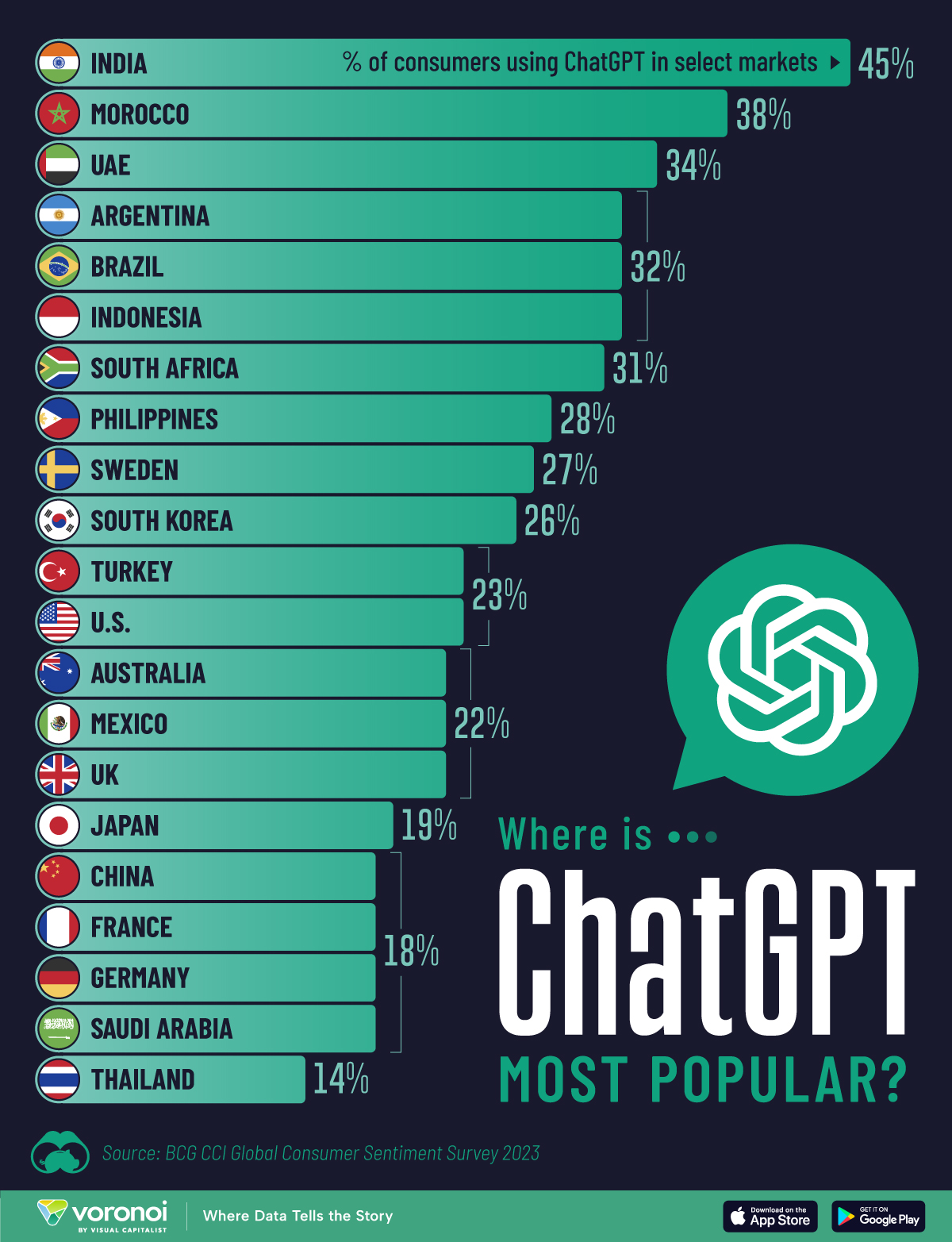The unexpected leaders in the ChatGPT usage by country

Since OpenAI unleashed ChatGPT nearly two years ago, the world has witnessed a transformative shift in how artificial intelligence is perceived and utilized. This tool, which sparked the generative AI revolution, quickly became a sensation, prompting people worldwide to explore its capabilities. With the initial excitement now settled, it’s time to examine how the global public is engaging with this technology. The Boston Consulting Group’s CCI Global Consumer Sentiment Survey 2023 shared by Voronoi provides valuable insights, revealing interesting patterns in ChatGPT usage across various countries.
 Statistics regarding ChatGPT usage (Image: visualcapitalist)
Statistics regarding ChatGPT usage (Image: visualcapitalist)
Surprising facts at a glance:
- Morocco’s high usage: Morocco ranks second, with 38% of its population using ChatGPT, which might be unexpected given that it isn’t typically highlighted as a global tech hub. This suggests a strong, perhaps underappreciated, engagement with AI in the region.
- Argentina’s position: Argentina is tied with Brazil and Indonesia at 32%, placing it in the top five. This is noteworthy considering that Argentina isn’t usually associated with high levels of tech adoption compared to other nations like the U.S. or Germany.
- Lower usage in technologically advanced countries: Countries like Japan (19%), Germany (18%), and France (18%)—all known for their technological advancements—have lower usage rates compared to many emerging markets. This could be surprising, indicating that cultural factors or different technological priorities may influence AI adoption.
- India’s leading position: While India’s leading position might be somewhat expected due to its large IT sector, the significant margin by which it leads (45%) is still notable. It underscores the country’s rapid digital transformation and strong adoption of AI technologies.
- The U.S usage: The U.S., often considered at the forefront of tech innovation, is ranked lower (23%) than countries like India, Morocco, and even the Philippines, suggesting that despite being a hub for AI development, the general population may not be adopting ChatGPT as quickly or as widely as expected.
A striking trend that emerges from the data is that younger countries, with a lower median age, are at the forefront of ChatGPT adoption. India tops the list, with 45% of surveyed individuals using the AI tool. This isn’t entirely surprising, considering India’s burgeoning IT sector, where tools like ChatGPT can significantly enhance productivity and innovation. The younger, more tech-savvy population in these countries seems to be leveraging AI not just for fun, but for practical, often professional purposes.
Morocco follows India with 38% of its population using ChatGPT, a reflection of the country’s growing interest in digital innovation. Similarly, the United Arab Emirates, Argentina, and Brazil also report high usage rates, hovering around the 32-34% mark. These countries, like India, are home to rapidly developing tech ecosystems, where AI is increasingly seen as a valuable asset in various industries.
 A striking trend that emerges from the data is that younger countries, with a lower median age, are at the forefront of ChatGPT adoption
The practical vs. the playful
A striking trend that emerges from the data is that younger countries, with a lower median age, are at the forefront of ChatGPT adoption
The practical vs. the playful
The way ChatGPT is used varies significantly across different regions, highlighting a cultural divide in the approach to AI. In countries like India and the Philippines, where ChatGPT usage is higher, AI tools are often employed for specific, goal-oriented tasks. For instance, users might rely on ChatGPT to assist in research, provide virtual personal assistance, or streamline work processes. This reflects a practical approach to AI, where the technology is integrated into everyday tasks to enhance efficiency.
On the other hand, in regions like the United States and Germany, where the percentage of ChatGPT users is lower (around 18-23%), the tool is often used more casually. According to the BCG survey, many respondents in these countries tend to “play around with it,” using AI for entertainment or exploratory purposes rather than as a critical tool in their daily routines. This contrast in usage highlights the varying degrees of AI integration into people’s lives, influenced by cultural, economic, and technological factors.
Addressing unmet needsFor those who see AI as more than just a novelty, the technology serves as a powerful tool to address unmet needs. This might involve creating personalized financial plans, finding tailored recommendations, or even searching for specific products that match their preferences. The ability of AI to provide customized solutions is a key factor driving its adoption in countries with higher ChatGPT usage.
In contrast, where usage is lower, this potential remains largely untapped, with many users yet to explore the full capabilities of AI. As more people begin to realize the practical benefits of tools like ChatGPT, we may see a shift towards more widespread and purpose-driven use of AI across these regions as well.
AI at work: A comprehensive guide
Regional disparities in AI sentimentWhile the excitement around AI is palpable in many parts of the world, sentiments towards the technology vary significantly. According to the BCG survey, around 40% of respondents globally express excitement about AI, seeing it as a tool for positive change. However, 28% of respondents feel conflicted, perhaps torn between the benefits and the potential risks of AI. Meanwhile, 29% express concern, likely driven by fears of job displacement, privacy issues, or the broader implications of AI on society.
These mixed feelings are reflected in the adoption rates of ChatGPT. In countries where AI is embraced with enthusiasm, like India and the UAE, higher usage rates correspond with a more optimistic outlook on the technology. Conversely, in regions where concerns about AI are more pronounced, such as parts of Europe, lower usage rates suggest a more cautious approach to AI adoption.
 The way ChatGPT is used varies significantly across different regions, highlighting a cultural divide in the approach to AI
What does the future hold?
The way ChatGPT is used varies significantly across different regions, highlighting a cultural divide in the approach to AI
What does the future hold?
As we look to the future, the trajectory of AI adoption is likely to be shaped by a combination of factors, including technological advancements, economic conditions, and cultural attitudes. In younger, rapidly developing countries, we can expect to see continued growth in AI usage, driven by both professional and personal needs. These regions are likely to lead the charge in integrating AI into various aspects of daily life, from work to leisure.
In contrast, in countries where AI is currently used more casually, there may be a gradual shift towards more purposeful applications of the technology. As people become more familiar with the capabilities of AI, the novelty is likely to wear off, giving way to a more pragmatic approach to its use. This could lead to increased adoption rates in these regions as well, particularly as AI tools become more accessible and user-friendly.
Illustration credits: Kerem Gülen/Midjourney
